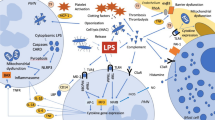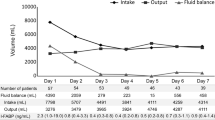Summary
We have found that endotoxemia detected by conventional LCT (limulus colorimetric test) in patients with liver diseases could not be detected by endotoxin-specific LCT at all, and proposed that this β-glucan like activity (BGLA) should be termed as non-septic endotoxemia, distinguishing it from septic endotoxemia seen in gram-negative sepsis. In this study, we investigated non-septic endotoxemia through the clinical course of 8 cirrhotic patients. Non-septic endotoxemia appeared at the onset of DIC but tended to decline in level in the late terminal stage. This phenomenon cannot be consistent with the “spillover” theory which explains the mechanism of endotoxemia without sepsis in liver disease. We think it is an urgent problem to elucidate the nature of BGLA in liver disease, without recourse to the “spillover” theory.
Similar content being viewed by others
References
Yajima Y, Otsuki M, Suzuki H, et al: Endotoxemia in various liver diseases and gram-negative septicemia using limulus colorimetric test (LCT). Jpn J Gastroenterol 1984;81:2538–2543 (in Jpn)
Yajima Y, Fukuda I, Otsuki M, et al: Endotoxemia in liver diseases: Detection by a quantitative assay using chromogenic substrate with perchloric acid pretreatment. Tohoku J Exp Med 1985;147:411–419
Yajima Y, Fukuda I, Otsuki M, et al: Re-evaluation of endotoxemia in liver diseases using Endotoxin-Specific (E-S) limulus colorimetric test. The 7th proceeding of the congress of endotoxin clinical research. Yotosha, Tokyo. 1987;47-54 (in Jpn)
Iwanaga S, Morita T, Miyata T, et al: The limulus coagulation system sensitive to bacterial endotoxins. In: Homma JY, et al, eds. Bacterial endotoxin: Chemical, biological and clinical aspects. Verlag Chemie, Weinheim 1984;365–382
Obayashi T, Tamura H, Tanaka S, et al: A new chromogenic endotoxin-specific assay using recombined limulus coagulation enzymes and its clinical applications. Clin Chim Acta 1985;149:55–65
Yajima Y: Biological activity of endotoxin and clinical significance of endotoxemia. Prog Med 1987;7:1085–1094 (in Jpn)
Tamura H, Obayashi T, Takagi T, et al: Perchloric acid treatment of human blood for quantitative endotoxin assay using synthetic chromogenic substrate for horseshoe crab clotting enzyme. Thromb Res; 1982;27:51–57
Candis DT, Reinhold RB, Woodruff PWH, et al: Endotoxemia in man. Lancet 1972;1:1381–1386
Wilkinson SP, Moodie H, Stamatakis JD, et al: Endotoxemia and renal failure in cirrhosis and obstructive jaundice. Br Med J 1976;2:1415–1418
Clemente C, Bosch J, Rodes J, et al: Funcional renal failure and haemorrhagic gastritis associated with endotoxemia in cirrhosis. Gut 1977;18:556–560
Tarao K, So K, Moroi T, et al;; Detection of endotoxin in plasma and ascitic fluid of patients with liver cirrhosis: Its clinical significance. Gastroenterology 1977;73:539–542
Liehr H, Grun M: Clinical aspects of Kupffer cells failure in liver disease. In: Wisse E, Knock DL, eds. Kupffer cells and other sinusoidal cells. Elsevier Publishing Co, Amsterdam-London-New York 1977;427–436
Fulenwider JT, Sibley C, Stein SF, et al: Endotoxemia of Cirrhosis: An observation not substantiated. Gastroenterology 1980;78:1001–1004
Yajima Y, Fukuda I, Otsuki M, et al: Comparison between limulus gelation test (LGT) and limulus colorimetric test (LCT). The 6th proceedings of the congress of endotoxin clinical research. Yotosha, Tokyo, 1985;47:53 (in Jpn)
Kitamura M, Nishihira T, Hirayama K, et al: Postoperative endotoxemia in patients with esophageal carcinoma. Jpn J Gastroenterol Surg. 1987;20:1648–1653 (in Jpn)
Nakagawa K, Matsubara S, Ouchi K, et al: Endotoxemia after abdominal surgery. Tohoku J Exp Med 1986;150:273–280
Yajima Y, Fukuda I, Otsuki M, et al: Stability of endotoxin detected in human plasma against endotoxin-inactivating factor (EIF): Quantitative analysis of EIF using chromogenic endotoxin assay Tohoku J Exp 1986;150:317–327
Takahashi K: Study on quantitative measurement of endotoxin in human blood using chromogenic substrate: Especially pretreatment of plasma. J Iwate med Ass 1988;40:67–81 (in Jpn)
Freudenberg MA, Bog-Hansen TC, Back U, et al: Interaction of lipopolysaccharides with plasma high-density lipoprotein in rats. Infect Immun 1980;28:373–380
Author information
Authors and Affiliations
Rights and permissions
About this article
Cite this article
Yajima, Y., Fukuda, I., Otsuki, M. et al. Non-septic endotoxemia in cirrhotic patients. Gastroenterol Jpn 24, 262–269 (1989). https://doi.org/10.1007/BF02774323
Received:
Accepted:
Issue Date:
DOI: https://doi.org/10.1007/BF02774323




